Hello all,
Today I will finish my article on the costumes of the Province of Noord-Brabant in the Netherlands, with the costume of the western part of the province, West-Brabant, also called The barony of Breda and The marquisate of Bergen op Zoom. Some minority costumes in this region will also be covered.
Breda and Bergen op Zoom have separate histories, but both wear this costume. Here is the approximate extent of West-Brabant, lying west of this line.
As in the central and eastern parts of North Brabant, the main costume has no distinctive features, but the caps used are unique. The caps in this area mostly developed from the historical Brabantse muts, the Brabant cap. This cap has long side lappets which are sometimes doubled, and no frill hanging from the neck. This is in contrast to the caps which are worn further east, in Den Bosch and Limburg. The top of the cap is often enlarged.
This woman is from Breda.
This woman is from Oosterhout.
Here are a couple of museum pieces of the old style cap from Etten-Leur. These have not been laundered or starched. Notice that the side lappets are doubled.
Hulst
The Brabant cap has been retained in the folk costume of Hulst, in southeastern Zeeland, close to the Brabant border. This costume belongs to the West Brabant type rather than the Zealand type. Note that here the cap has a ribbon tied around the base of the lappets.
Just east of this area, in the extreme southwest of North Brabant, lies the region of
Ossendrecht.
Here the cap is called the Speldenmuts, or pin cap. The only ornament used in this region, besides the basic lace, is hundreds of tiny pins, often copper, inserted parallel to each other down the center of the lappet, lengthwise. This first one only has them on the top half, perhaps they got lost.
Willemstad, Finjaart and the north
This area has more in common with costumes to the north and east. The cap included a ruffle in back. The daily cap was often crotched, and this rear ruffle was kept.
The Catholic women of Oudenbosch wore either the old Brabant cap, or later, the cap of Breda and Bergen op Zoom.
Zundert and Chaam
This region lies in the south of this area, and is the home of the so called Belgian Cap.
This cap is worn only in these two southern extensions of western North Brabant. It has a back of lace, and several rows of goffered lace around the face. The back is ornamented with wide colored ribbons which hang down behind.
This cap is worn over a headband with fake hair locks and a black undercap. See below for the manner of putting them on.
The rest of the costume is similar to that of Bergen and Zoom, and in all parts of this province they are fond of wearing Paisley shawls. Some more images of the Belgian cap costume.
Breda and Bergen op Zoom
This costume was worn in the central corridor of West Brabant, from Bergen op Zoom east to Breda area, roughly indicated on the map above. There were two basic types of caps worn here for dress occasions. The Strakke Muts, and the Plooimuts, also called the Dubbele Muts.
The Strakke Muts, or 'tight fitting cap' is less expensive and fancy than the Plooimuts, 'pleated cap', or Dubbele Muts, 'double cap'. Not everyone could afford the Plooimuts. The Plooimuts differed in that the side lappets are gathered or pleated, and the dressy overlay was more elaborate. Caps for mourning were made of plain opaque linen with no lace.
By themselves, the Strakke Muts. The first is an everyday cap, very plain, and the second is more dressy, made of finer lace.
After this a black undercap is put on, as is usual all over the Netherlands. Care is taken that the forehead band is visible. This protects the lace cap from the hair, and provides contrast for the lace.
After this the strakke muts itself is put on. The lappets fit tightly to the head, and the back is full, showing off the lace.
For dressier occasions, a band with looped ribbons and some artificial flowers are put on over the muts.
The form of the plooimuts is similar, but the lappets are gathered and goffered. This, of course, requires much more lace.
It is put on the same way, but instead of wearing the strap, the 'crown' is put on instead. This is a rather large puff of artificial flowers, somewhat similar to the 'poffer' worn further east, but it is confined to the forehead area.
This is obviously more elaborate and expensive than the strakke muts, and not all women could afford one, but those who could wore it on more dressy occasions.
There were two kinds of headgear worn for workdays. The first is sometimes called the lol, and resembled the girls' cap of eastern Brabant and Limburg. It was made of printed cotton, with many ruffles and bows.
The other is a basket shaped straw hat, called kaphoed, hood. This was used as protection from the sun and the elements. It was worn over a lace muts. It was ornamented with wide decorative ribbons.
Men in these photos are either wearing a suit from the appropriate time period, or are wearing smocks and workman's caps.
Thank you for reading, I hope that you have found this to be interesting and informative. To those of you who perform Dutch dances, perhaps you will consider adding these costumes to your repetoir.
Roman K.
email: rkozakand@aol.com





.jpeg)


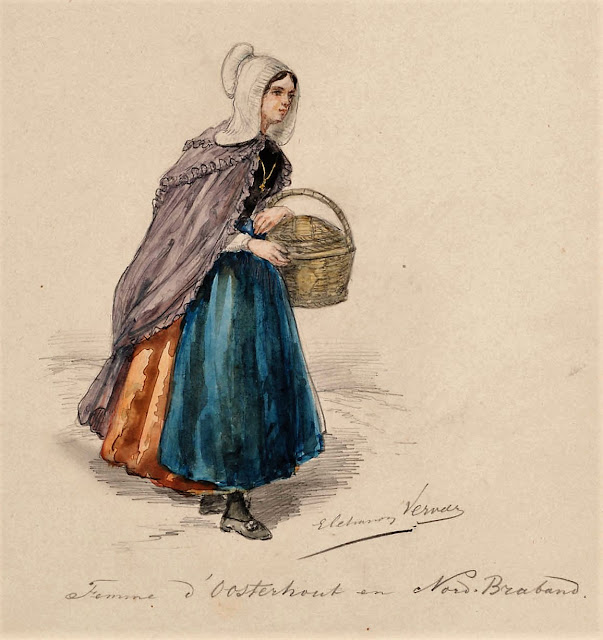

.jpeg)




.jpg)









.jpg)







.jpg)

.jpg)
.jpeg)




lichte%20rouw%20uit%20Willemstad.jpeg)

.jpeg)
.jpg)







%20muts%20uit%20Chaam,%20ca.%201890.jpeg)
.jpg)
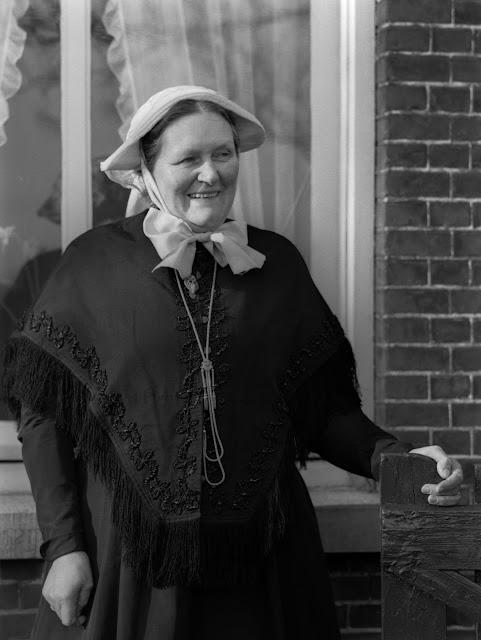

.jpg)

.jpg)





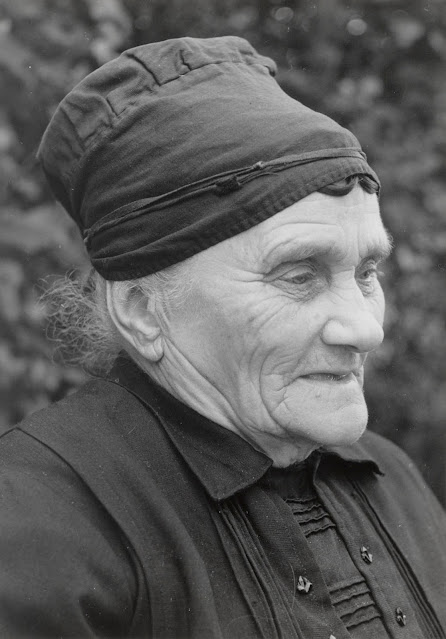













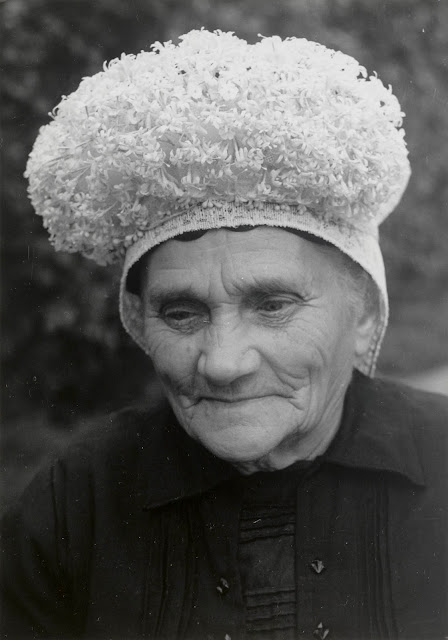
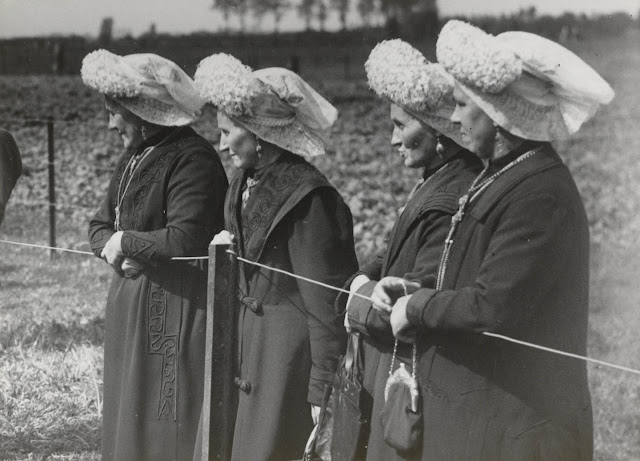







%20(2).jpeg)
.jpeg)


.jpeg)

.jpeg)
.jpeg)




,%20girl.jpeg)
,%20woman%20(2).jpeg)
met%20haar%20zus%20Gerardina%20(1880)%20en%20broer%20Johannes.%20Maria%20is%20de%20staande%20vrouw.%20De%20meisjes%20dragen%20beide%20de%20zwarte%20kindermuts%20omdat%20ze%20nog%20geen%2018%20jaar%20zijn.jpg)


.jpeg)

















,%20man%20(2).jpeg)





















.jpeg)


.jpg)






.jpeg)
.jpeg)
.jpeg)
.jpeg)
.jpeg)
.jpeg)
.jpeg)
.jpeg)
.jpeg)
.jpeg)



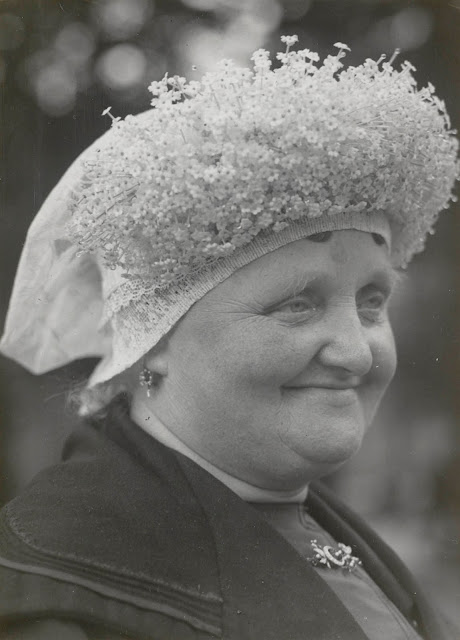
%20met%20de%20blesjes%20nog%20onder%20haar%20muts%20uitkomend.%20Zij%20draagt%20een%20pelerine%20met%20gitten%20versierd%20en%20een%20gouden%20keelbroche%20en%20oorhangers..jpg)






